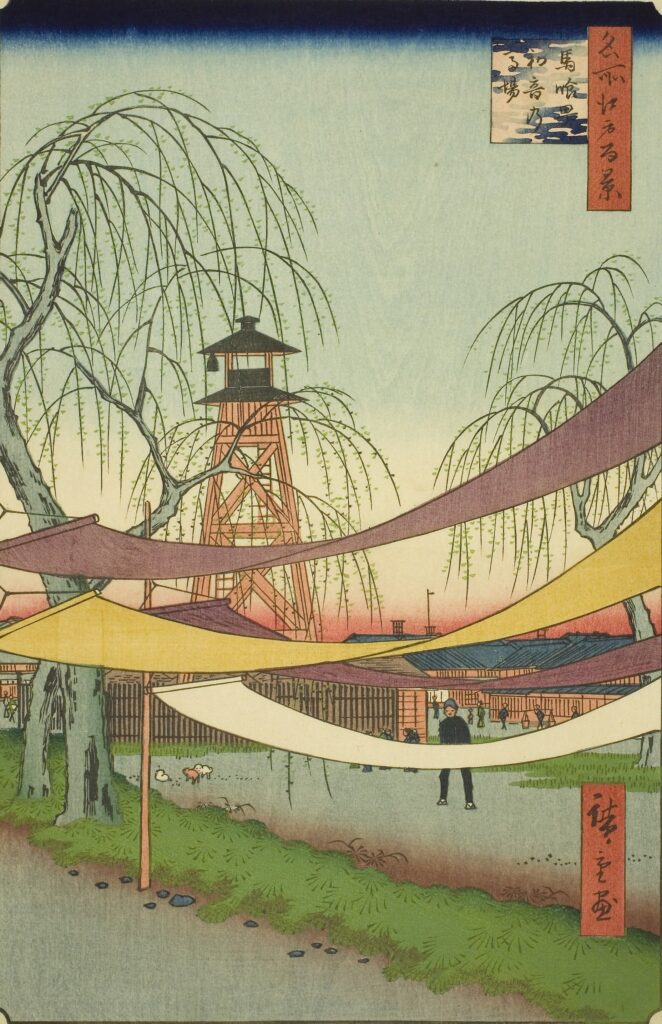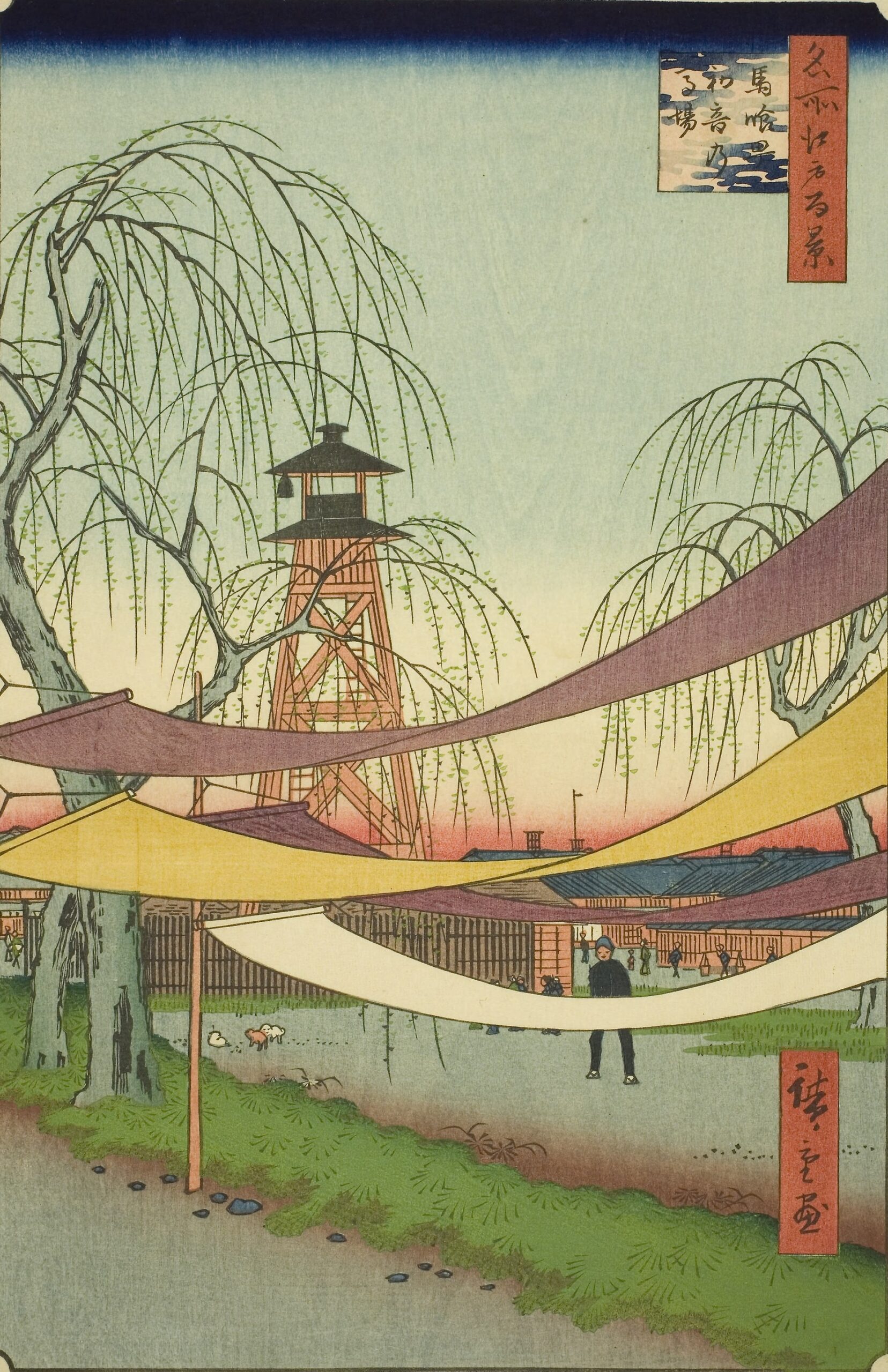
Utagawa Hiroshige – One Hundred Famous Views of Edo – 6 – Spring – Bakuro-cho Hatsune no Baba (Hattle Field of Hatsune) – Commentary 歌川広重-名所江戸百景-6-春-馬喰町初音の馬場 解説
Current Address: Near Higashikanda 1-chome, Chiyoda Ward
Latitude and Longitude: Latitude 35.6942, Longitude 139.7822
Published: September 1857 Age: 61
Commentary
<1> Introduction
“Bakuro-cho Hatsune no Baba” is a work depicting a space known as a venue for equestrian and martial arts training, despite being located in the heart of Edo.
This area, located near present-day Higashikanda 1-chome, Chiyoda Ward, Tokyo, was famous during the Edo period for its horse training grounds, where samurai warriors used to train their horses.
Hiroshige depicts the atmosphere of the horse field amid the urban landscape of Edo, conveying the intersection between the samurai society and the lives of ordinary people in Edo at the time.
<2> About Bakuro-cho and Hatsune Baba
“Bakuro” refers to merchants who bought and sold horses.
This town hosted a horse market, and many people involved in buying, selling, and raising horses lived here.
Located near the outer moat of Edo Castle and adjacent to Nihonbashi Bridge, it offered convenient transportation and was in high demand for horses.
Horses were essential to samurai and played an important role in demonstrating military power and authority.
For this reason, Bakuro-cho was an important area for samurai.
Hatsune Baba was established as a training ground for samurai to train in horse riding and equestrianism.
The ability to control a horse was an essential skill for samurai since the Sengoku period, and was valued as a samurai hobby even during the peaceful Edo period.
This is Edo’s oldest riding ground, and it is said that Tokugawa Ieyasu prepared his horses for the Battle of Sekigahara.
The name “Hatsune” comes from the nearby Hatsune Inari Shrine.
This corresponds to the area around present-day Higashi-Nihonbashi Station and Bakuro-cho Station.
The existence of a riding ground in the center of Edo speaks to the unique characteristics of the urban structure of the time.
Although the riding ground was a training ground for samurai, it faced the town, so commoners could also see them.
The sight of horsemen being ridden was a kind of spectacle for commoners, and it was also a place where they could experience the proud presence of samurai.
<3> Highlights of the painting
The long, stretching riding ground is depicted using perspective to emphasize the depth of the space.
The vast, linear space that suddenly appears in the city of Edo makes a strong impression on the viewer.
The painting depicts samurai riding horses and people pulling them, vividly conveying the state of the riding ground at the time.
The details of the horse equipment and costumes also give a sense of the dignity of samurai society.
In the background, a row of town houses and Edo city buildings suggest that the city and a place for martial arts coexisted.
This composition symbolizes the unique feature of Edo, where a “samurai’s space” existed within urban life.
Four rolls of dyed fabric are drying in the center, creating a lively atmosphere.
<4> The appeal felt by the common people of Edo
The sight of samurai riding their horses with gusto was an object of admiration for the common people. Being able to see this on a daily basis in the streets of Edo was a privilege unique to Bakuro-cho.
Horse markets were also held here, so for common people, horses were an extension of the market for everyday goods.
The voices and energy of those who handled the horses added a lively atmosphere to the town.
With the end of the Warring States period, equestrianism became more of an “art” than a military one.
The riding grounds were a stage where samurai showed their pride, but they also served as an entertainment space for common people to enjoy.
<5> Walking Around Bakuro-cho Today
Bakuro-cho is a key transportation hub, located on the JR Sobu Line Rapid and near the Asakusabashi and Higashi-Nihonbashi subway stations.
While traces of its bustling horse trading past from the Edo period have faded, the place name “Bakuro-cho” still conveys its history.
There are historical signboards throughout the town, where you can learn about the remains of Edo’s horse racing grounds and the history of the merchant district.
Walking around the area, you’ll get a sense of its progress as a commercial city from the Edo period through the Meiji period.
Close to downtown areas like Kanda, Nihonbashi, and Ningyocho, you can experience the multifaceted nature of Edo culture.
<6> Tourist Guide
1. Tracing the History Remained in Place Names
The name “Bakuro-cho” is a reminder of Edo’s horse culture. Keep an eye out for signs and historical sites as you walk.
2. Explore the Surrounding Bridges
Famous landmarks painted by Hiroshige, such as Nihonbashi and Ryogokubashi, are within walking distance.
3. Historical Stroll + Modern Cuisine
Take a break at a long-established restaurant or cafe and savor the vestiges of Edo.
4. Ukiyo-e in Hand
Comparing Hiroshige’s ukiyo-e prints with modern-day landscapes will give you a real sense of the city’s transformation and continuity.


